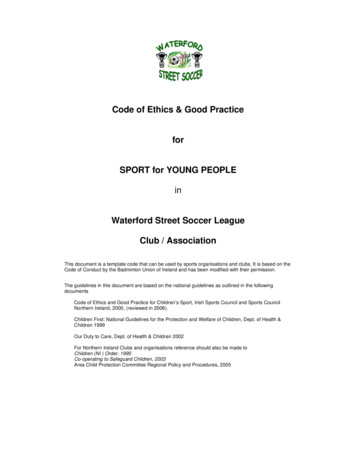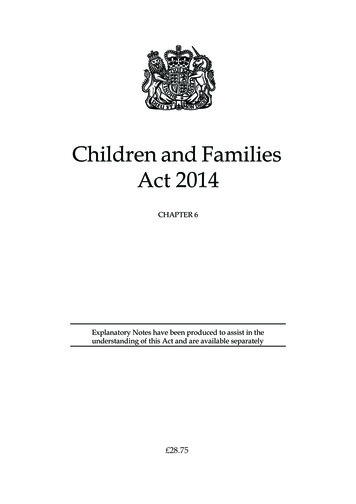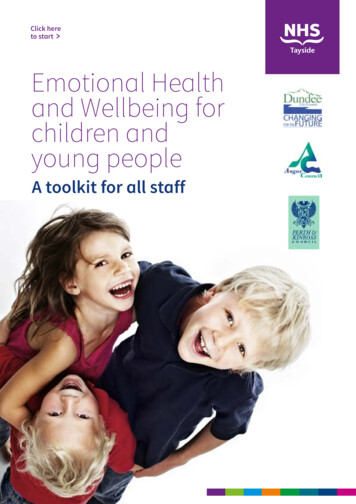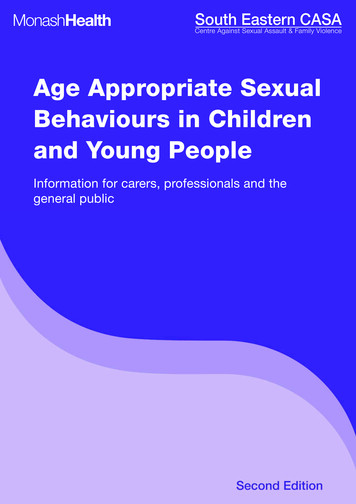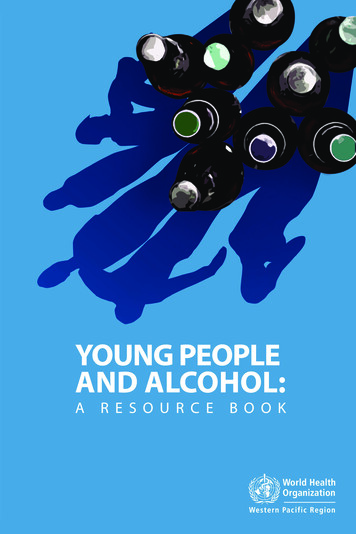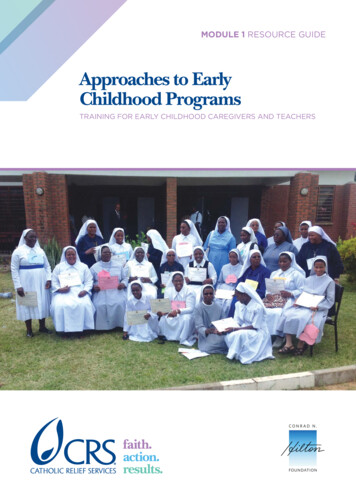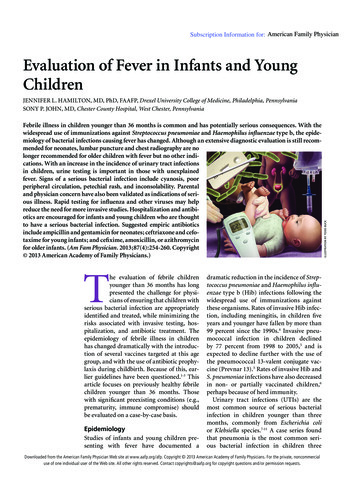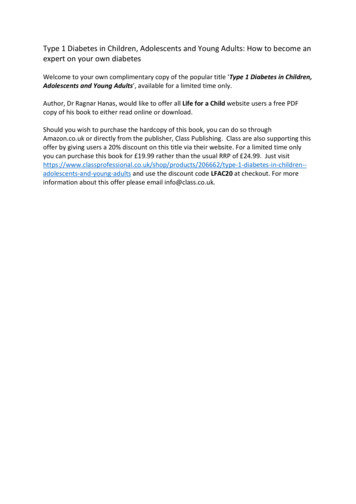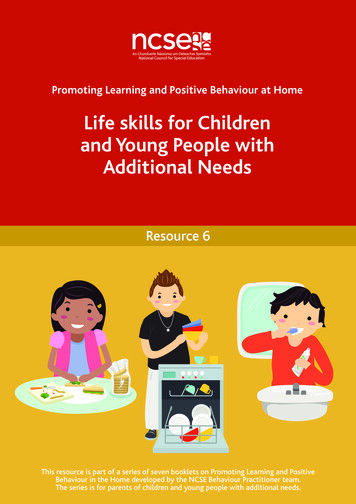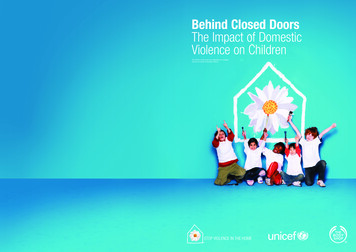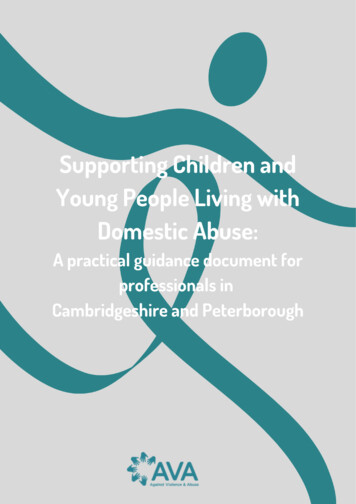
Transcription
1AcknowledgementsAVA is incredibly grateful to all the participants in the focus groups who have provided the vital data for this guidance.We are also grateful to Cambridgeshire County Council for commissioning and providing full funding for the regionalconsultation that served as the basis for this guidance.This guidance was produced by Cordelia Ruck and dr. Jasna Magić.We are grateful to Vickie Crompton and Julia Cullum, Domestic Abuse & Sexual Violence Partnership Managers forCambridgeshire and Peterborough for all their support with the first draft of this guidance.About AVAAVA is a feminist organisation committed to creating a world without gender-based violence and abuse. Our mission isto work with survivors to end gender-based violence by championing evidence-based change. We are a nationalcharity, independent and particularly recognized for our specialist expertise in multiple disadvantage and children andyoung people’s work. Our core work includes training, policy, research, and consultancy.AVA run the CODA programme (Children Overcoming Domestic Abuse) Programme, a national concurrent groupwork programme for mothers and children adaptable locally to flex with your capacity and demand. If you would liketo talk with us about running the programme in your area or would like information to pass to commissioning collegesplease email info@avaproject.org.ukPlease cite this resource as: AVA (2021): Supporting children and young people living with domestic abuse: a practicalguidance document for professionals in Cambridgeshire and Peterborough. London, AVA.
2Contents1. About this guidance2. Context3. How do children/young people who experience domestic abuse at home present?4. How should I communicate with a child/young person about domestic abuse in a safe and age appropriatemanner?5. How should I respond to a disclosure of domestic abuse from a child/young person?6. How do I ensure the safety and welfare of children/young people still living with domestic abuse?7. How can I support the non-abusive parent?8. How can I work with other agencies to ensure children/young people living with domestic abuse areappropriately supported?9. Checklist34681214182022
31. About this guidanceThis guidance was commissioned by Cambridgeshire County Council to help shape local guidelines and best practicein providing support for children/young people who are living with conflict, abuse, and violence at home. Focus on theneeds of children has grown as a result of the changed status of child survivors arising from the Domestic Abuse Act2021.¹This guidance draws on four key sources:1. Three (3) face-to-face focus groups with young people; focus groups took place in: Cambridge, March and Wisbech;total number of participants 35, average age 16.2. Four (4) online focus groups with professionals and practitioners based in Cambridgeshire, representing theeducation, social work, domestic abuse and ending violence against women and girls (VAWG) sectors; total number ofparticipants 54.3. Best practice identified across AVA’s in-house resources and work; e.g. Ask AVA² and General Guidelines forResponding to Child Survivors (in-house document, unpublished).4. Rapid literature review on needs of children/young people experiencing domestic abuse at home.The guidance follows headline themes from both sets of focus groups. It focuses on providing information on how tosupport/meet the needs of children/young people living with domestic abuse perpetrated by a parent or a sibling inthe home, as opposed to other forms of domestic abuse children/young people may face or perpetrate.We would like to acknowledge there are a wide range of services and agencies supporting children/young people inCambridgeshire and Peterbourough. These services and agencies will be working within different external andinternal policies, legal obligations and with families at different stages of intervention either inside or outside of thehome. To acknowledge the differences in aspired outcomes and legal/policy frameworks agencies and services needto follow, this guidance is not prescriptive. While we aimed to cover different aspects of support that children/youngpeople may need, recommendations in this guidance should be considered in line with your organisational policiesand mandate.This guidance focuses on highlighting approaches on how to practically work with children and young people who arestill living with the domestic abuse perpetrator. We also include a guide on working with the non-abusive parent onhow to discuss children's safety and pass on tools and techniques to their child. While we do include limitedinformation on signposting and referral process, this is not the main focus of this guidance.This guidance consists of eight key sections. Section 1: Outlines information on aims and structure and provides information on data collection Section 2: Provides information on policy context and outlines relevant statistics Section 3: Provides information on how children/young people experiencing abuse at home might present Section 4: Provides guidance on how to communicate with the child/young person to encourage disclosure Section 5: Provides guidance on appropriate responses once disclosure has been made Section 6: Provides guidance on risk assessment and safety planning Section 7: Provides guidance on how to support the non-abusive parent Section 8: Provides information on multi-agency work, signposting and referrals.Keeping children/young people safe is everyone’s responsibility. All organisations and professionals working withchildren/young people are in a vital position when it comes to identifying those who may be experiencing domesticviolence/abuse and providing support, whether immediate or long term.1. Domestic Abuse Act 2021: nts [last access 16.11.20212. Main ASK AVA website: https://ask-ava.org.uk/ [last access 16.11.2021]
42. ContextDomestic abuse and children/young peopleThe new Domestic Abuse Act (2021) defines domestic abuse as any of the following: “physical or sexual abuse; violentor threatening behaviour; controlling or coercive behaviour; economic abuse; psychological, emotional or otherabuse.” For the definition to apply, both parties must be aged 16 or over and ‘personally connected’. People who are‘personally connected’ are defined as: intimate partners, ex-partners, family members or individuals who shareparental responsibility for a child.Part 1 of The Act provides that a child who sees, hears, or experiences the effects of domestic abuse and is related tothe person being abused or the perpetrator is also to be regarded as a victim of domestic abuse in their own right,and, as such, services need to ensure that they are responding to their needs.Although this guidance specifically focuses on children/young people living at home and experiencing violence andabuse by their parents and/or sibling, it is important to acknowledge the other forms of domestic abusechildren/young people may be victim to, or abusive behaviours they may adopt.Children/young people may also face or perpetrate the following forms of domestic abuse: teenage relationshipabuse, forced marriage, female genital mutilation (FGM), sexual exploitation, sexual harassment and bullying, and childto parent violence.³Rates of domestic abuse in Cambridgeshire:Domestic abuse is hard to quantify, reliance on police data hides help seeking from schools, family and friends,health and other professionals. With this caveat we note that; The rate of domestic abuse related crime in Cambridgeshire has increased in the last 5 years, from 4.2 to 7.6.⁴ In 2020-21, a total of 1,176 domestic abuse cases were heard at MARAC.⁵ In 2020-21, there were 2,324 referrals to the Independent Domestic Violence Advisor Service for domestic abuse,an increase of 18% on 2019-20, over half of those open to the IDVA service have dependent children in 2020-21,refuges across the county housed 93 women and 112 children.⁶National rates of children/ young people experiencing domestic abuse:Not all children/young people face the same risk of abuse; those who identify as LGBT , those with mixed or multipleethnic background, and disabled children, all face higher rates of abuse in childhood. One in seven (14.2%) children/young people under the age of 18 will have lived with domestic abuse at some pointin their childhood.⁷ 692 children daily are assessed as being at risk of domestic abuse in England.⁸ Two in five children (41%) living in families where there is domestic abuse have been living with that abuse sincethey were born.⁹3. See ASK AVA’s ‘Understand’ section for an explanation of each form of domestic abuse and the ‘Resources’ section for tools to support children andyoung people [last access 16.11.2021]4. Cambridgeshire Research Group, 2019. Domestic Abuse-Related Crimes and Incidents Cambridgeshire: 2014/15 - 2018/19: loads/2019/10/Domestic-Abuse-Infographic.pdf [last access 16.11.2021]5. Cambridgeshire and Peterborough Domestic Abuse and Sexual Violence Partnership, 2021. Annual Report 2020-21 [last access 16.11.2021]6. Ibid. p.37. Women’s Aid (2019): Impact Of Domestic Abuse On Children And Young People. [last access 16.11.2021]8. Action for Children (2019): Patchy, Piecemeal and Precarious: support for children affected by domestic abuse. [last access 16.11.2021]9. SafeLives (2017): SafeLives Insights National Briefing 2017 Children, young people, and the involvement of Children’s Services. [last access 16.11.2021]
5The impact of domestic abuse for children/young peopleAt their core children are resilient and creative problem solvers, with the right support children and young people canovercome the choices of perpetrators and the impact of their behaviour on them. Within this understanding researchshows that without the right support; Living in a home where domestic abuse happens can have a serious impact on a child or young person's mentaland physical welfare, as well as their behaviour, this can last into adulthood.¹⁰ Children/young people who experience domestic abuse face higher risk of experiencing emotional, physical andsexual abuse, of developing emotional and behavioral difficulties in their lives.¹¹ Domestic abuse in childhood may lead to depression, anxiety and suicidal thoughts and feelings, as well as physicalhealth problems such as higher rates of physical illness.¹² Evidence suggests that children over ten are much more likely to try to intervene to stop physical abuse, and almosta third of children feel like the abuse is their fault.¹³Children will often ask whether domestic abuse happens in other families. Understanding the scale and the impact ofdomestic abuse can help you as a practitioner to manage questions that young people and children have aboutwhether ‘they aren’t the only one’.10. Refuge, NSPCC (2011): Meeting the Needs of Children Living With Domestic Violence In London. [last access 16.11.2021]11. Holt, S., Buckley, H. and Whelan, S. (2008): The impact of exposure to domestic violence on children and young people: A review of the literature, ChildAbuse & Neglect, 32(8), pp. 797-810. [last access 16.11.2021]12. NSPCC (2021): Protecting children from domestic abuse. [last access 16.11.2021]13. SafeLives (2017): SafeLives Insights National Briefing 2017. [last access 16.11.2021]
63. How do children/young people who experience domesticabuse at home present?Top 5 hints and tips:1. Think about how trauma manifests in abusive behaviours and relationships.2. Consider different types of domestic abuse as defined by the Domestic Abuse Act.3. Consider different signs of domestic abuse; keep in mind children/young people mightreact differently to abuse.4. Consider the child/young person’s behaviour in response to their siblings, parents andpeers.5. Trust your professional instincts, if you suspect there is abuse in the home, askquestions.Any child or young person can experience domestic abuse, but not all children/young people react the same way, andsiblings in one household may have different reactions to abuse and relationships with the perpetrator.It’s important to be aware of how domestic abuse victim-survivors might present in your service. Remember, there isno universal way or one thing to watch for, and, in some cases, there may be no obvious ‘indicators’. Most important isyour relationship with that child or young person and your professional curiosity about changes in behaviouralpatterns as a potential indicator of domestic abuse.Source: Ask AVA
7When looking for potential indicators, it is important to consider the family as a whole. This may include looking at thechild/young person’s behaviour in response to their siblings, parents and peers. Evidence suggests children/youngpeople may take on different roles in the household where abuse is present. This may include: caretaker, mother'sconfidant and abuser's confidant.¹⁴Most important when working with children/young people is to trust your professional instincts. If you suspect thechild or young person is experiencing abuse, make sure to ask questions about domestic abuse in the home (see nextsession).14. Baker, L. & Cunningham, A., 2004. ‘What about me?’: Seeking to Understand a Child’s View of Violence in the Family.
9We know children/young people most often come to the attention of services through their behaviour and demeanour, rather than through explicitly disclosing abuse. This is why it’s important that professionals are able to recognisesigns of abuse and are aware of the need to ask questions rather than assuming that a child or a young person willdisclose if something is happening in the home.Source: Perthshire Women's AidBuilding rapportIt is important that professionals working with children/young people invest time in building rapport and restoringtrust. Clarity on what will happen as a result of conversations with you is key to ensuring trust is protected.Children/young people may have lost trust in professionals from previous encounters, may struggle feeling comfortable around adults due to the abuse faced and the direct messages of perpetrators, or may be afraid of the consequences of building relationships with professionals.Often disclosure or recognition of domestic abuse may come as an end result of a child/young person building atrusting relationship. Key considerations include: Get to know the child/young person, for example, their likes and dislikes, wishes and hopes. Be clear about your role and what you can/cannot do for the child/young person. Remain consistent in your approach and availability to the child/young person. Be clear about the limits of your confidentiality from the get-go. You may wish to discuss: the circumstancesthat will necessitate you telling someone else, who you may tell, and why you need to do this. Providing examples canbe a useful way to help children/young people understand what ‘immediate risk of harm’ looks like in practice. Offer options for communication including digital technology (e.g. webchat, phone calls, online forums, chatbot). Take a trauma-informed approach. Do not assume that resistant behaviour is a result of disinterest or thechild/young person being ‘difficult’, it is likely a protective strategy. Work closely with the non-abusive parent to support the child/young person (where appropriate). (See pg xxx ofthis guidance).
84. How should I communicate with a child/young personabout domestic abuse in a safe and age appropriatemanner?Top 5 hints and tips:1. Children/young people are unlikely to recognise and articulate their experience asdomestic abuse.2. Build rapport, use non-blaming, sensitive, and age appropriate language whendiscussing domestic abuse with children and young people.3. Make sure children/young people are aware of the limits of your confidentiality andfully understand your role, before asking them any questions or offering support.4. Create a safe and supportive environment encouraging disclosure.5. Tailor your communication to every child/young person as an individual.We know children/young people most often come to the attention of services through their behaviour and demeanour, rather than through explicitly disclosing abuse. This is why it’s important that professionals are able to recognisesigns of abuse and are aware of the need to ask questions rather than assuming that a child or a young person willdisclose if something is happening in the home.When attempting to explore experiences of abuse with children/young people, do not assume: A child/young person is too young to comprehend or internalise what is happening around them. All children/young people in the household have experienced or perceived the abuse in the same way. The non-abusive parent will be able to accurately determine the child/young person's experiences of abuse.A note on identity, perpetrators are skilled at using identity and protected characteristics to create barriers to helpseeking. Take care to disrupt the perpetrators narratives and control by offering choice around how children andyoung people present themselves to you and avoid assumptions on sexuality, gender-identity, race and disabilities.Barriers to communication and disclosureProfessionals must recognise that children/young people may think differently about the risks of disclosing abuse.The table below outlines just some of the barriers and fears they may have around sharing their experience with you.
10LanguageUse non-blaming, sensitive, and age appropriate language when discussing domestic abuse with children/youngpeople: Listen, believe and affirm what a child or young person shares with you. It’s important for them that they feeltheir experience is validated and that you genuinely care. Give the child/young person space and time to share. Suggested phrases include: ‘Take as much time as youneed ’, ‘Please don’t feel forced to talk share as much or as little as you like’. Avoid using the term ‘domestic abuse’ which children/young people may not understand or relate to. Instead,you may wish to use terms like: ‘fighting’, ‘bullying’, ‘arguments’ and ‘hurting’ - especially when working with youngerchildren. Consider disabilities and additional vulnerabilities: for example, if working with a deaf/hard of hearingchild/young person, a child/young person with special educational needs (SEN), make sure you have a support froma communication support worker (CSW) or a learning support assistant Consider language difficulties: for example, needs of a child/young person where English is not their firstlanguage, make sure you do not use parents or siblings as interpreters for any child/young person. Use different methods to communicate: If a child/young person is unable or struggles to verbally communicate,make every attempt to communicate through using toys, arts and crafts, activity booklets to support the child/youngperson to communicate and express their feelings and emotions. This is especially useful when discussing domesticabuse where younger children may not know how to verbalise what they have seen/heard. Using Scaling Questions: rather than ask children and young people how things are at home, ask them to let youknow on a scale of 0 - 10 - orient towards positive.Useful resources: For more on supporting Disabled children, see NSPCC’s ‘We have a right to be safe’ and ‘Safeguardingd/Deaf and disabled children’. For more on discussing domestic abuse with children/young people of different ages (in a school setting),see ASK AVA ‘how to work with different ages’. For children aged 5-15 it may be useful to use a genogram to support them in exploring their home lifecontext. See: Leeds SCP Children’s Genogram Resource. It may also be useful to use an ecomap to identify dynamics within the family. An example version isavailable here: Ecomap Activity. Practitioners may wish to use activities with children/young people to facilitate ease in identifying theiremotions, wishes, wants and feelings. For example, Derby City Council: Three Islands activity pack. See Barnardos' ‘Say it your own way’: Children’s participation in assessments: resources for a number ofactivities and resources to support communication with younger children around themselves and their homelife. See ‘The Solution Focused Approach with Children and Young People: Current Thinking and Practice’, forsolution focused questions and scales to help build an accurate picture of home life.Create a safe and supporting environment to encourage disclosure: Raise questions regarding domestic abuse with a child/young person when they are in a private place. If suitable,offer the child/young person the opportunity to be seen alone, or with their preferred trusted adult. (If possible) Ask the child/young person what type of environment they would like to meet in. For example,this may be school, at home, or on a walk.
11 Create an inviting, friendly environment. For example, by offering a snack or drink or inviting them to bringanything that makes them feel safe into the space (e.g. a toy, blanket, phone etc.). Invite the child/young person tooccupy the space in a way they feel most comfortable (e.g. standing vs. sitting down). Non-verbal communication is key to creating a safe environment, and professionals should consider their bodylanguage, for example, sitting next to rather than opposite the child/young person. Dress code is important. Think about how clothing (depending on the age of a child/young person), can be abarrier or can help build relationship and trust, to encourage disclosure.Useful resources: Sterne, A. and Poole, L. (2010). Domestic Violence and Children: A handbook for schools and early yearssettings.Asking questions about domestic abuseIt is important to ask children/young people questions to gain insight into their experiences, their level of safety andwhat types of support they would like to receive. Do not ask leading questions. If you suspect something has happened, use open-ended questions e.g. rather than‘did dad hit mum?’ use ‘you said mum got hurt, how did she get hurt?’ Never force a child or young person to answer questions when they appear uncomfortable to do so, especially if a particular adult is making the child/young person visibly uncomfortable. Be prepared to spend time exploring what abuse is. The young people you work with may not identify their ownexperiences as abuse. If you suspect something is going on, but the child/young person does not disclose, continue sensitively openingup the conversation around safety in the home at future meetings.Example questions for encouraging disclosure and exploring experiences of domesticabuse:‘ Who is in your family?’ ‘Who lives in the house with you?’, ‘Who comes and visits you?’ ‘What's your relationship like with mum/dad/parents?’, ‘What do you like to do with mum/dad/parents?’ ‘Who are you the most/least close to in the family?’, ‘Who makes you feel safe in the family?’ ‘How are things at home? Is everything alright at home? Do you feel safe (at home)?’ ‘Are there some things that happen in your family that are scary? Do you ever feel threatened (by yourparents or siblings)? /Do your parents (or other family members) put you down, threaten or hurt you?’, ‘Does‘parent 1’ ever hurt/scare/put down/insult ‘parent 2’?‘ What do you do when scary things happen?’, ‘When do scary things tend to happen?’, ‘What do you thinkneeds to happen to make things better at home?’/ ‘What can you/others do to change things?’Useful resources: See London Safeguarding Children’s Partnerships': Safeguarding Children Affected by Domestic Abuse ‘Appendix Four: Communicating with Children’ for more ideas on the types of questions you may want to askchildren/young people living with domestic abuse.
125. How should I respond to a disclosure of domestic abusefrom a child/young person?Top 5 hints and tips:1. Believe the child/young person and take their concerns seriously.2. Make sure that any steps you take are in line with the child’s wishes and aligns withyour safeguarding principles and practices3. Be transparent about what will happen next especially if you need to involve otherservices/agencies.4. Present the child/young person with options and give them choice over how theyare supported.5. Make sure you have access to regular and scheduled support and feedback, tosupport your own mental health and wellbeing.Any disclosure of abuse should be treated seriously, with appropriate steps taken in line with your organisation’ssafeguarding procedures. Remember that best practice in safeguarding is person centred and led by child focusedoutcomes.1. Receive Listen, but do not look shocked or disbelieving. Mirroring their language and reflecting back what they haveshared will help the young person feel listened to. Try not to show any anger or shock you may be feeling at thatmoment. It can be difficult when hearing distressing or upsetting details, but try as hard as possible to retainneutral and supportive language. Take what they are saying seriously and believe them. Thank the child/young person and affirm theirdisclosure. Suggested phrases include ‘I believe you’, ‘Thank you for telling me’, ‘You’ve done the right thing bytelling me’. Do not ask probing questions or suggest answers as this may undermine any investigation by the police orenquiry by Children’s Social Care Services. Do not make the child or young person feel bad. For example, resist saying things like ‘You should havetold me earlier’, ‘Why didn’t you mention this when I asked before?’2. Ressure Stay calm, tell them that they have done the right thing by telling you, and not to feel worried that they havedone the wrong thing by telling you. Acknowledge how hard it must have been to tell you. Suggested phrases include: ‘You are very brave to haveshared this with me’, ‘You have done the right thing by telling me’. Tell them that they are not to blame. Reassure the young person that the abuse is not their fault and it’s nottheir responsibility to stop it from happening. Suggested phrases: ‘This is not your fault’, ‘You have done the rightthing by telling me’. Empathise, but do not tell them how they should be feeling.
13 Do not promise confidentiality. You may want to explain that only those that need to know will be told (i.e.the designated staff member for child protection). Never promise to keep a secret. Be honest about what you can and cannot do.3. Respond Do not interrogate, instead let them tell you as far as possible. Do not ask probing questions. Remember, it's not your job to find out ‘who, where, when?’ at this stage. Refer your concern on to the appropriate party/parties in accordance with your child protectionprocedures. This must be done in a timely fashion. Record the date, time and any information given to you. Always use the words they said to you; neverinterpret what was said or put it in your own words. Record what you did next and with whom you shared the information. Do not criticise or judge the abuser - the child or young person may have feelings for him/her - you riskalienating the child/young person by passing judgement on the perpetrator.Any disclosureof abuseshouldbe treatedseriously,appropriatesteps takenin linetowithorganisation’sTry to followthingsthroughyourselfso theywithdo notneed to repeattheir ncentredandledbychildfocusedif this is in line with procedure).outcomes. Explain what will happen next, for example, who you may tell, that they may wish to speak to thechild/young person, if it is safe the non-abusing parent may be informed, you may need to involve otherservices / organisations. Make sure you are supported. It can be distressing dealing with this type of information. Remember tomaintain boundaries with your work and to reach out to your team when you need support.Adapted from Ask AVAAfter these first steps, ensure the child/young person and (where appropriate) the non-abusive parent are involved inthe follow-up processes as much as possible.Consider: Inviting them to follow up meetings. If it is not appropriate for them to attend the meeting or they are unable to,you may want to inform them about the meeting, what will be discussed, who will be there, and ask if there isanything they would like for you to share at the meeting. Asking who they would like to attend meetings. For example, the child/young person may want the non-abusiveparent present, or they may prefer a different trusted adult. Presenting them with options and giving them choice over how they are supported. When sharing signpostinginformation about what support is available, be led by and allow the child/young person to have a choice in thisprocess. If relevant, keep them up to date about any referrals made, who might contact them and when.Useful resources: The governments ‘Working Together to Safeguard Children’. AVA’s online resource hub ‘looking after yourself’ including resources to support managingsecondary trauma.
146. How do I ensure the safety and welfare of children/youngpeople still living with domestic abuse?Top 5 hints and tips:1. Ensuring safety and welfare is about ensuring open communication and engagement,children and young people are at most risk when professionals are unaware of theirsituation.2. Safety plan and risk assess in a collaborative and open way; involve the child/youngperson you are supporting in safety planning and risk management. Remember safety isbuilt over time and not ‘done to’ children and young people.3. If appropriate, work with and consider involving non-abusive adults in the familysystem in safety planning.4. Empower young people and help them build their support networks, resources andsafety strategies.5
ethnic background, and disabled children, all face higher rates of abuse in childhood. One in seven (14.2%) children/young people under the age of 18 will have lived with domestic abuse at some point in their childhood.⁷ 692 children daily are assessed as being at risk of domestic abuse in England.⁸
